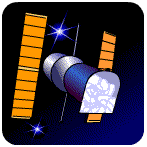The Tenth Planet
Created | Updated Dec 15, 2009

Astronomers have been arguing about how many planets our solar system contains ever since Galileo first incurred the wrath of the Catholic church by pointing his telescope at Jupiter. As telescopes have got more powerful, the number of known planets has gone up to nine. The most recent, Pluto, was discovered in 1930 by Clyde Tombaugh and orbits in a region of space known as the Kuiper Belt, where the debris left over from the early solar system, swept out by interactions with the giant planets, hangs around1. The Kuiper Belt is full of the sort of 'small' lumps of ice and rock one finds in space, an example of which probably wiped out the dinosaurs and plunged Earth into darkness about 65 million years ago.
The dumping ground for solar debris is the Oort Cloud. This cloud is a spherical shell of this rubbish, and is up to a light year in diameter with the Sun at its centre. As the rubbish orbits the Sun it experiences various tugs and pulls from the galactic core and some of it gets disturbed enough in its orbit to be sent towards the Sun, giving rise to 'long period' comets, such as Hale-Bopp, which then orbit the sun in an elliptical path. Since the shell is spherical, the rubbish comes in from all directions.
The Discoveries of John Matese and John Murray
Two astronomers, John Matese and John Murray, independently reported that a significant number of these comets originated from a narrow arc-shaped band of space within the Oort Cloud. This is exactly what would be expected if a large body was orbiting the Sun at about half a light year, scattering proto-comets in all directions and sending some to a fiery death. The putative planet is huge; its mass has been placed at one-and-a-half to six times the mass of Jupiter, which is, in itself, rather large as planets go. Its orbit would have to be steeply inclined to that of the other planets, and it probably orbits the sun in the opposite sense, both features indicating that it was probably not formed along with the other planets but a wandering body that was captured by the Sun's gravity.
The existence of this tenth planet is still very much hypothetical, being inferred rather than observed directly (as are many other cosmic phenomena). Astronomers will need very powerful telescopes to see a dim planet at half a light year's distance, especially against a background of bright stars. The most likely place it could currently be found is in the constellation Delphinus. If it exists, it's likely to be there for some time, since at that distance it would take six million years to complete an orbit of the sun.
The confirmation of the existence of a tenth planet, especially an interstellar interloper, would be a momentous event for everyone interested in the heavens.
The h2g2 Tour of the Solar System
Take the h2g2 Shuttle for your whistle-stop tour of the Solar System.
- Next Stop (Inward Journey):
- Last Stop (Outward Journey):

